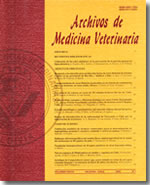Environmental factors affecting lactation curve parameters in the United Kingdom's commercial dairy herds
Main Article Content
Abstract
The purpose of this study was to investigate the environmental factors affecting lactation curve parameters derived from a biological model. The biological approach to lactation curve fitted 2 logistic curves to mimic the initial increase in milk secretory cell numbers in early lactation, and the progression of apoptosis in late lactation. Records from 182,987 Holstein-Friesian cows were analysed. Main factors such as cow, herd and lactation number accounted for 74% of the total sum of squares (P < 0.001). The average age at first calving was 28 months; which had a significant effect on all curve parameters. Increments of age at first calving from 20 to 40 months, were associated with linear increments in total milk yield, and calculated total milk yield. Parameters from the increasing phase of lactation such as maximum secretion potential, growing midpoint from start of lactation to peak yield, and peak yield, were highly correlated amongst themselves (> 0.60). Curve parameters, maximum secretion potential and peak yield were highly correlated indicating that these two parameters are practically the same. Additionally, high estimates of maximum secretion potential and peak yield resulted in high total milk yield. The early day of peak had an adverse effect over persistency of lactation given by the high correlation between day of peak and persistency (0.64). Cow, herd, lactation number and age at first calving were the most determining factors on the lactation curve of first calving and multiparous dairy cows.

